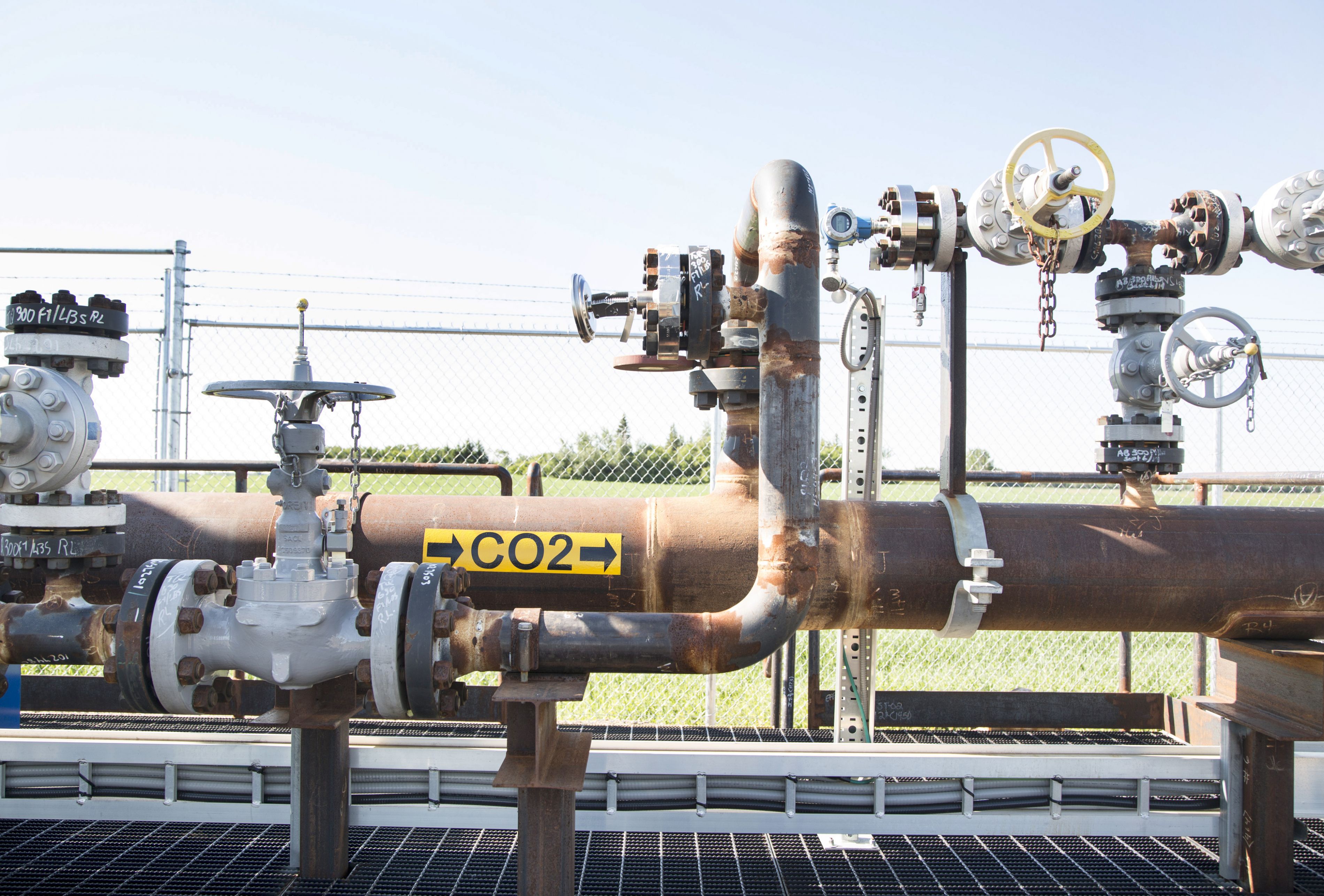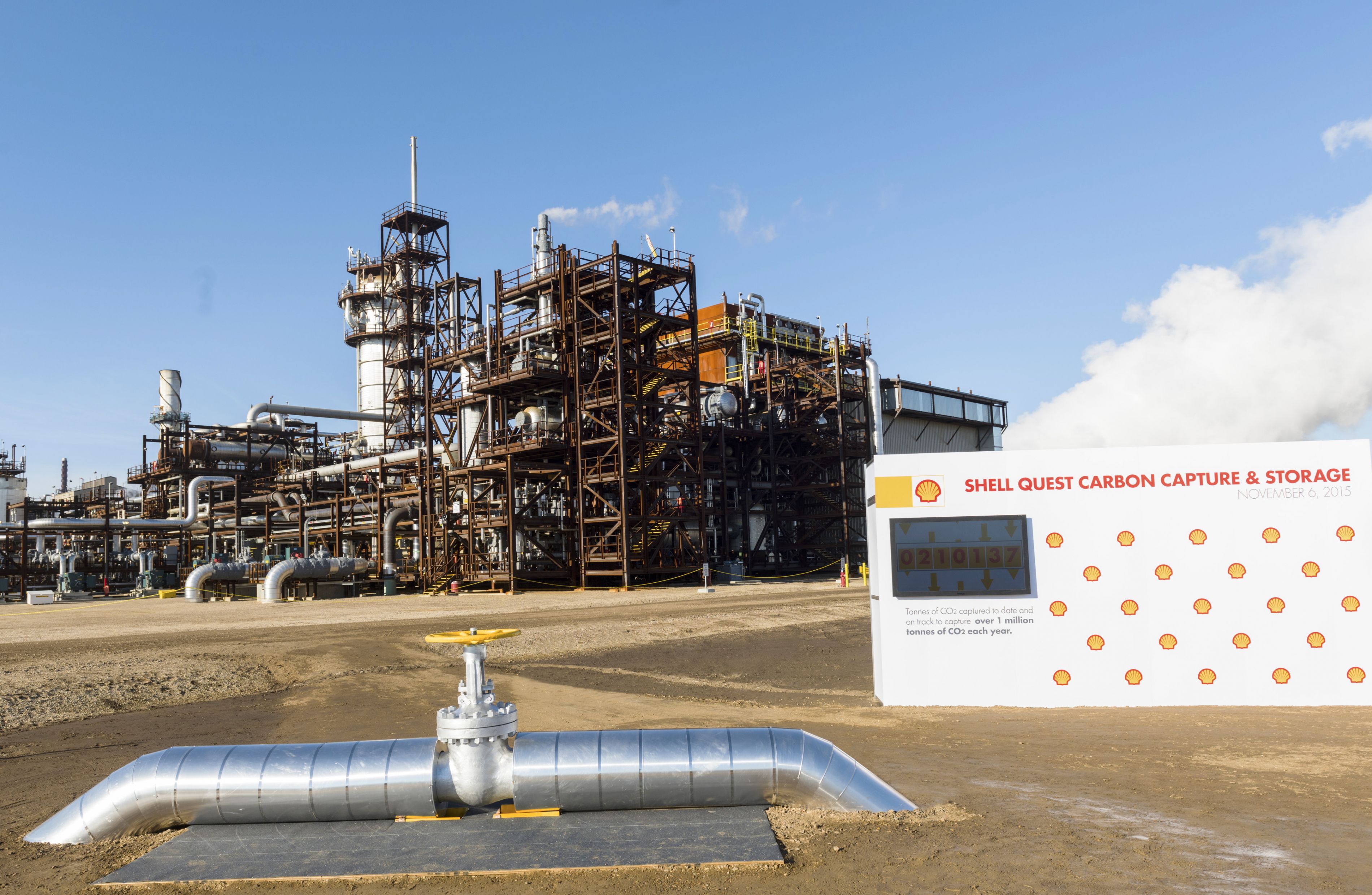Shell Canada Energy Quest Project
Lead proponent: Shell
Location: Northern Alberta
CEF contribution: $120M
Project total: $1310M
Project Background:

Upstream Americas, Heavy Oil – A line break valve and part of the Quest Project CO2 pipeline near Fort Saskatchewan (northeast of Edmonton), Alberta in June 2015
The Athabasca Oil Sands Project (AOSP) consists of the Shell Albian Sands mining and extraction operations, north of Fort McMurray, Alberta and the Scotford Upgrader. Shell Albian Sands includes two mines – the Muskeg River Mine and the Jackpine Mine. Ore containing bitumen is excavated from the mines, and then taken to crushers where it is prepared for extraction. Using warm water, bitumen is separated from sand and clay, and then diluted with solvent for transport via pipeline to the Scotford Upgrader. The Scotford Upgrader is designed to process and convert 255,000 barrels of oil equivalent per day of diluted bitumen into synthetic crude oil. Shell is the operator and majority shareholder of AOSP - a joint venture between Shell Canada (60%), Chevron Canada Limited (20%) and Marathon Canadian Oil Sands Holding Limited (20%).
Extracting bitumen and other heavy crude oil requires more energy than the production of lighter and more accessible forms of crude oil. This tends to make heavy oil production more emissions-intensive per barrel of oil produced. Carbon Capture and Storage (CCS) is a technology that can be used to help reduce the impact by capturing CO2 and storing it underground. To that end, Shell (the operator and majority shareholder of the AOSP) proposed the construction of “Quest”. Quest, Shell’s flagship CCS project, would capture and permanently store more than 1 million tonnes of CO2 each year - one-third of the emissions from the Scotford Upgrader. Quest was awarded $120M from CEF (and $745 million from the Province of Alberta).
Results:
Planning and preliminary design of Quest began in the third quarter of 2009. Construction of the capture system followed, in the second quarter of 2012, after a full year of engineering design. The system captures CO2 from the process gas streams of three hydrogen-manufacturing units (HMUs) at the Scotford Upgrader. A commercially proven activated amine process whereby CO2 is absorbed (captured) into the amine solution and then regenerated to produce at least 95% CO2 purity is used. The CO2 is then compressed by an electrical drive compressor to a maximum dense-phase pressure of about 12 megapascals and transported through a 12-inch diameter pipeline to a storage site located approximately 80 kilometers north of the Scotford Upgrader, near Thorhild, Alberta.
Work on the pipeline began in the third quarter of 2013. The pipeline is safeguarded through the use of line break valves stationed at regular intervals and the installation of flow meters for leak detection. Regulator field monitoring and proactive corrosion management is also implemented to ensure the integrity of the transport system. The line is buried to a depth of 1.5 metres except where there are line break valves. Extensive consultation and discussions with landowners yielded a feasible final routing of the pipeline that obtained consent from the landowners. More than 30 pipeline routing changes were made in order to accommodate concerns raised by landowners.
Selection of a CO2 storage site for the project required careful consideration of criteria such as rock formation properties, the number of legacy wells in and around the storage complex (to reduce risk of potential leak paths), and proximity to densely populated areas (to minimize the number of landowner consents). Moreover, it was critical for the project that the storage site selected would not be impeded by future CCS projects. To that end, Shell applied for and was granted pore space tenure for exclusive use of the Basal Cambrian Sands (BCS) formation for the project, within the Sequestration Lease Area (SLA) by the Province of Alberta. Storage properties of the BCS complex were validated through analysis of the data obtained from drilling a test well into the planned storage location.
Two additional injection wells and three deep monitoring wells (one next to each injection well) were drilled between the end 2012 and early 2013. CO2 is injected approximately 2 km underground into the BCS geological formation by means of these injection wells. Since the BCS formation is situated below layers of impermeable, continuous and thick cap rock, CO2 will be trapped within the pore spaces of the rock formation, preventing upward migration.

The ceremonial valve and associated photo backdrop used to mark the official launch of the Quest Carbon Capture and Storage (CCS) Project with the Quest unit in the background (Shell Scotford, November 6, 2015)
Construction reached mechanical completion on February 10, 2015 with all deficiencies addressed on all systems. Following that, the amine unit as well as the regeneration successfully started up in late May. The compressor and dehydration units were started up in August. The pipeline was filled and injection into the first well was achieved on August 23rd. On September 30th, 2015, Quest received certification for the successful completion of commercial operating tests. The entire system was subsequently handed over to Shell Scotford for sustained operation.
A detailed measurement, monitoring and verification (MMV) plan has been developed and is being implemented by Shell to monitor the storage of CO2. The MMV plan includes atmospheric, biosphere, hydrosphere, geosphere, and well-based monitoring. Data from downhole pressure and temperature (DHPT) gauges installed in the injection and deep monitoring wells, as well as data from water level loggers in the groundwater wells, are collected via a supervisory control and data acquisition (SCADA) system linked to the Production Information (PI) database at Scotford.
The Quest project began commercial operations in November 2015, and successfully captured and safely stored 1 million tonnes of CO2 by September 2016, well ahead of schedule. Quest’s early success is due in large part to strong collaboration between Shell, joint venture owners and the governments of Alberta and Canada. Quest has demonstrated how significant cost savings can be achieved through joint transportation and storage facilities, and all intellectual property or data generated by Quest is publicly available. This will enable further cost reductions, and wider use of CCS technologies around the world.
Benefits to Canada:
Quest is the world’s first commercial-scale CCS project to tackle carbon emissions in the oil sands and is expected to reduce CO2 emissions in Canada by 1 million tonnes per year. The success of Quest proves that the technology is feasible and functioning and can be applied in industries such as oil and gas, fertilizer, chemicals, cement, and other large emission sources. Quest has drawn interest from governments and education institutions in Korea, Mexico, Taiwan, Norway, and UK.
Next Steps:
Ongoing stakeholder engagement activities will enable local residents to be aware of how the project is progressing and the activities undertaken to safeguard them. Shell will continue to engage various levels of government and industry to share knowledge gained and project progress. MMV technologies and systems put in place will be used to help ensure that the capture and pipeline facilities and storage site perform as expected, and that the CO2 is handled and stored in a safe and secure way. Moreover, Quest has entered into a relationship with the US Department of Energy to test advanced MMV technologies.
Page details
- Date modified: